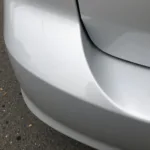Keyed car scratches are an unfortunate reality for many car owners. Discovering a deep, deliberate scratch along the side of your vehicle can be incredibly frustrating. This guide will help you understand the different types of scratches, how to assess the damage, and provide you with practical steps on how to repair keyed car scratches yourself, potentially saving you hundreds of dollars in professional repairs.
Knowing how to repair keyed car scratches yourself can save you a lot of money. First, you need to assess the damage. Not all scratches are created equal. Some are superficial, affecting only the clear coat, while others penetrate deeper into the paint or even the metal. Understanding the depth of the scratch is crucial to determining the right repair method.
Assessing the Damage: How Deep is the Scratch?
Before you start any repair, wash the area thoroughly with car wash soap and water. This will remove any dirt or debris that might interfere with your assessment and the repair process. Once clean, you can accurately determine the depth of the scratch. A simple test is running your fingernail across the scratch. If your fingernail catches, the scratch is likely deep enough to require more than just a simple polish.
If the scratch is light and you can’t feel it with your fingernail, it’s likely a clear coat scratch. These can often be buffed out with a rubbing compound. Deeper scratches that reach the paint layer will require a touch-up paint and clear coat. And finally, the deepest scratches, those that expose the metal underneath, require the most attention and might be best left to professionals, especially if rust is present. Need to know more about a complete car repair after a keying incident? Check out our guide on keyed my car repair.
DIY Keyed Car Scratch Repair: A Step-by-Step Guide
For minor to moderate scratches, a DIY repair is often possible. Here’s a detailed guide:
-
Clean the Area: Thoroughly clean the scratched area with car wash soap and water. Dry completely.
-
Sanding (If Necessary): If the scratch is deep enough to feel with your fingernail, you’ll need to lightly sand the area with 2000-grit sandpaper. This will smooth the edges of the scratch and prepare the surface for the touch-up paint. Keep the sanding localized to the scratch itself.
-
Apply Touch-Up Paint: Using a fine-tipped brush or a touch-up paint pen, carefully apply the touch-up paint to the scratch. Apply thin coats, allowing each coat to dry completely before applying the next. For helpful kits, check out keyed car repair kit.
-
Leveling (If Necessary): If the touch-up paint creates a raised area, you can use 2500-grit or 3000-grit sandpaper to carefully level the area once the paint is completely dry.
-
Apply Clear Coat: Once the touch-up paint is dry and level, apply a few thin coats of clear coat, allowing each coat to dry completely.
-
Buffing and Polishing: After the clear coat has dried for at least 24 hours, you can buff and polish the area to blend the repair with the surrounding paint. Find out more about doing it yourself by visiting our guide on diy keyed car repair.
When to Call a Professional
While minor scratches can often be repaired at home, deep scratches or those that have rusted should be handled by a professional. They have the expertise and tools to repair the damage properly and prevent further rusting. Wondering about the costs? Our guide on how much is it to repair a keyed car can give you an idea.
Prevention is Key
Preventing keyed car scratches is always better than having to repair them. Park in well-lit areas, away from high-traffic zones. Consider installing a car alarm or security cameras to deter vandals. If you’re looking for repair services in a specific area, like Birmingham, you can find information on keyed car repair birmingham.
 Preventing Keyed Car Scratches: Parking in a Well-Lit Area
Preventing Keyed Car Scratches: Parking in a Well-Lit Area
Conclusion
Dealing with how to repair keyed car scratches can be a hassle, but understanding the process and taking the right steps can save you time and money. By assessing the damage correctly and following the steps outlined in this guide, you can often repair minor to moderate scratches yourself. However, remember to seek professional help for deeper or more complex damage.
FAQ
-
Can I use any kind of touch-up paint? No, it’s crucial to use touch-up paint that precisely matches your car’s paint code.
-
How long does the repair take? The drying time for the paint and clear coat is crucial, and the entire process can take a day or two.
-
What if the scratch is too deep? For very deep scratches, consult a professional for the best results.
-
Can I wax the repaired area? Yes, after the clear coat has fully cured (typically a few weeks), you can wax the area.
-
What if the scratch is on a plastic bumper? The process is similar but may require specific plastic primers and paints.
-
Can I prevent keyed car scratches entirely? While not foolproof, parking in safe, well-lit areas can significantly reduce the risk.
-
Where can I find my car’s paint code? The paint code is usually located on a sticker inside the driver’s side door jamb, glove compartment, or under the hood.
Need more help? Contact us via WhatsApp: +1(641)206-8880 or Email: [email protected]. Our customer support team is available 24/7.


